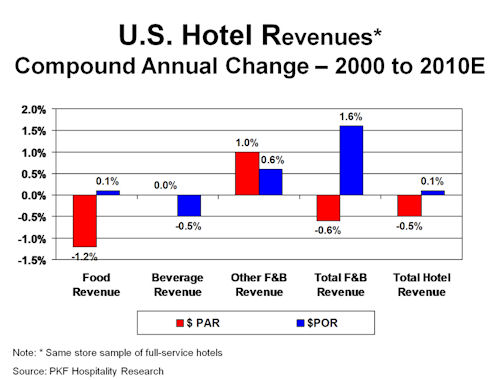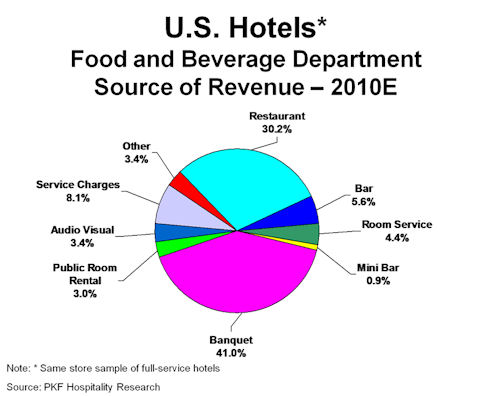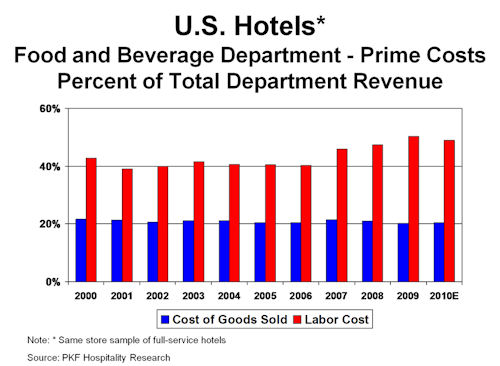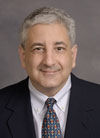|
News for the Hospitality Executive |
|
By:
Robert Mandelbaum,
June 14, 2011 In past articles, PKF Hospitality Research (PKF-HR) has labeled the period 2000 to 2010 as the “lost decade” for the U.S. lodging industry. During this volatile period, hotel revenues remained virtually flat through two major recessions and one extended period of prosperity. On the surface, it appears that hotel food and beverage (F&B) revenue followed a similar pattern. To understand recent trends in hotel food and beverage departments, PKF-HR studied the financial performance of hotel restaurants, lounges, and catering departments for the period 2000 to 2010. The information came from a same-store sample of full-service hotel operating statements taken from PKF-HR's Trends® in the Hotel Industry database. These hotels average 413 rooms in size, and offer multiple F&B outlets and extensive banquet facilities. Hotel data was estimated for 2010. Total hotel food and beverage revenue decreased slightly from 2000 to 2010 within the study sample. Measured on a compound annual basis (CAGR), F&B revenue declined 0.6 percent. This is comparable to the 0.5 decline in total hotel revenue experienced by these same properties. However, when analyzed on a dollar-per-occupied room basis, hotel F&B revenue increased 1.6 percent on a compound annual basis during the decade. This is significantly greater than the 0.1 percent rise in total hotel revenue per occupied room. During the study period, the number of occupied rooms declined 0.5 percent CAGR.  The relative stability of F&B revenue per occupied room can be partially explained by the ability of hotels to attract local patrons to their restaurants, lounges, and catering facilities. This is especially evident during the recessionary years of 2001, 2002, 2003, and 2009 when the declines in food and beverage revenue were less than the decreases observed in rooms revenue. Conversely, during the prosperous years of 2004 through 2007, total hotel revenues grew stronger than F&B revenues. During these years, stout increases in both occupancy and average room rates boosted total hotel revenue. This implies that the ability of hotel managers to raise room rates is greater than their ability to increase F&B prices. Sources of F&B Revenue Averaging 413 rooms, it is not surprising that banquet related revenue was the greatest source of F&B revenue for study sample in 2010. The combination of catering revenue, public room rental income, audio visual fees, and banquet service charges accounted for an estimated 55.5 percent of total F&B department revenue. Other sources of F&B revenue included restaurants (30.2%), lounges (5.6%), and room service (4.4%). It is interesting to note that the combined beverage sales within the hotel restaurants were twice as great as the liquor revenue generated at the bars within these properties. Whole bottle wine sales in the restaurants partially explain this disparity.  Due to changes in the Uniform System of Accounts in the Lodging Industry (USALI) it is not possible to equitably compare changes in F&B revenue by source over the 2000 to 2010 period. However, changes in revenue can be estimated for 2009 to 2010. From 2009 to 2010, total F&B revenue increased 8.6 percent. This compares favorably to the 6.5 percent increase in total hotel revenue for the study sample during the same period. The greatest increases were observed in beverage revenue (9.4%), followed by food revenue (9.1%) and other F&B revenue (6.2%). Other F&B revenue consists of public room rental, audio/visual, and service charge income. Of note is the fact that the majority of growth in beverage revenue came from catering events as opposed to the hotel bars. Expenses and Profits Food and beverage profitability is dictated by management's ability to control the prime costs of labor and costs of goods sold. From 2000 to 2010, the prime costs of F&B departments in our sample averaged 64.3 percent of total department revenue. Labor costs during this period averaged 43.4 percent, while the cost of goods sold averaged 20.9 percent. This cost of goods sold number includes expenses associated with the other F&B revenue sources. If you examine the combined costs of goods sold for just food and beverage sales, the average ratio rises to 29.1 percent. Hotel departmental profit margins averaged 26.4 percent from 2000 to 2010. In accordance with the USALI, this ratio is calculated before undistributed expenses such as marketing, maintenance, and utilities. Once again, the depth of the recession becomes evident. The lowest level of F&B departmental profitability was experienced in 2009 (21.6%), while the greatest profit margin was observed in 2000 (32.6%).  Food and beverage operations within the lodging industry have become a story of haves, and have nots. The vast majority of new properties and brands entering the U.S. lodging industry offer either limited, or no F&B service at all. On the other end of the spectrum are full-service hotels with multiple restaurants, lounges, and banquet facilities. For these full-service hotels, the offering of F&B is not just a source of revenue, but an amenity used to position the property within the marketplace. Losses within the F&B department are no longer tolerated by owners. F&B managers struggle to contain costs and grow revenues. The ability of management to attract local patrons, boost catering revenue, and increase beverage sales within their restaurants are examples of successful tactics that have generated profitable revenue.  Robert Mandelbaum is
Director of Research Information Services for PKF Hospitality
Research. To learn about the tools PKF-HR offers to
benchmark the performance of hotel F&B operations, please visit www.pkfc.com/benchmarker.
This article was published in the May 2011
edition of Lodging.
|
| Contact:
Robert Mandelbaum |
| Also See: | FREEBIES:
Hotels Give Some Things for Nothing / Robert Mandelbaum / April 2011 |
| Hang
Up The Phone And Hold The Starch, But Please Park The Car / Robert
Mandelbaum /February 2011 |
|
| Meeting
Planners Optimism Rising / Robert Mandelbaum / January 2011 |
|
| How
Profitable Will Your RevPAR Be In 2011? / Robert Mandelbaum /
December 2010 |
|
| No
Show – No Problem; Hotels Profit from Attrition and Cancellation Income
/ Robert Mandelbaum / November 2010 |
|
| Right
Direction - Wrong Amount: Hotel Managers Underestimated 2009 Declines
in Performance / Robert Mandelbaum / October 2010 |
|
| Surprised, or Stubborn? U.S. Hotel Managers Missed Their Budgets In 2008 / Robert Mandelbaum / October 2009 |